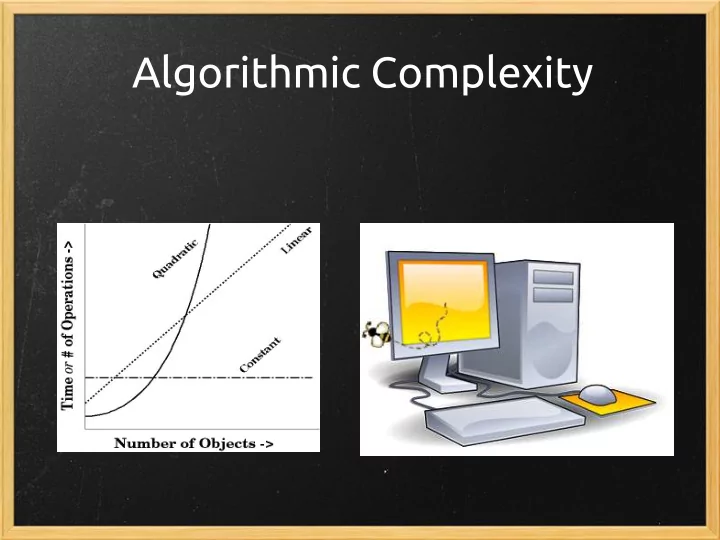

Algorithmic Complexity
Algorithmic Complexity "Algorithmic Complexity", also called "Running Time" or "Order of Growth", refers to the number of steps a program takes as a function of the size of its inputs. In this class, we will assume the function only has one input, which we will say has length n.
Algorithmic Complexity Notes on Notation: Algorithmic complexity is usually expressed in 1 of 2 ways. The first is the way used in lecture - "logarithmic", "linear", etc. The other is called Big-O notation. This is a more mathematical way of expressing running time, and looks more like a function. For example, a "linear" running time can also be expressed as O(n). Similarly, a "logarithmic" running time can be expressed as O(log n).
Algorithmic Complexity Here is a list of some common running times: Constant O(1) Logarithmic O(log n) Linear O(n) Quadratic O(n 2 ) Cubic O(n 3 ) Exponential O(2 n ) We will talk about each briefly.
Constant-Time Algorithms - O(1) A constant-time algorithm is one that takes the same amount of time, regardless of its input. Here are some examples: ● Given two numbers * , report the sum ● Given a list, report the first element ● Given a list of numbers * , report the result of adding the first element to itself 1,000,000 times Why is the last example still constant time? *Here, we are referring to numbers of a set maximum size (i.e. 32-bit numbers, 64-bit numbers, etc.)
Logarithmic-Time Algorithm - O(log n) A logarithmic-time algorithm is one that requires a number of steps proportional to the log(n). In most cases, we use 2 as the base of the log, but it doesn't matter which base because we ignore constants. Because we use the base 2, we can rephrase this in the following way: every time the size of the input doubles, our algorithm performs one more step . Examples: ● Binary search ● Searching a tree data structure (we'll see what this is later)
Linear-Time Algorithms - O(n) A linear-time algorithm is one that takes a number of steps directly proportional to the size of the input. In other words, if the size of the input doubles, the number of steps doubles. Examples: ● Given a list of words, say each item of a list ● Given a list of numbers, add each pair of numbers together (item 1 + item 2, item 3 + item 4, etc.) ● Given a list of numbers, multiply every 3rd number by 2 Again, why is the last algorithm still linear?
Quadratic-Time Algorithms - O(n 2 ) A quadratic-time algorithm is one takes a number of steps proportional to n 2 . That is, if the size of the input doubles, the number of steps quadruples. A typical pattern of quadratic- time algorithms is performing a linear-time operation on each item of the input (n steps per item * n items = n 2 steps). Examples: ● Compare each item of a list against all the other items in the list ● Fill in a n-by-n game board
Cubic-Time Algorithms - O(n 3 ) A cubic-time algorithm is one that takes a number of steps proportional to n 3 . In other words, if the input doubles, the number of steps is multiplied by 8. Similarly to the quadratic case, this could be the result of applying an n 2 algorithm to n items, or applying a linear algorithm to n 2 items. Examples: ● Fill in a 3D board (or environment) ● For each object in a list, construct an n-by-n bitmap drawing of the object
Exponential-Time Algorithms - O(2 n ) An exponential-time algorithm is one that takes time proportional to 2 n . In other words, if the size of the input increases by one, the number of steps doubles. Note that logarithms and exponents are inverses of each other. Algorithms in this category are often considered too slow to be practical, especially if the input is typically large. Examples: ● Given a number n, generate a list of every n-bit binary number
What is the runtime?
What is the runtime? Linear
What is the runtime?
What is the runtime? Quadratic
What is the runtime?
What is the runtime? Quadratic
What is the runtime?
What is the runtime? Linear
What is the runtime?
What is the runtime? Logarithmic
What is the runtime? Take a look at the code to the right. What is it doing? What is its running time? Hint: it drew the picture below.
What is the runtime? Take a look at the code to the right. What is it doing? What is its running time? Hint: it drew the picture below. Quadratic
What is the runtime?
What is the runtime? Logarithmic
What is the runtime?
What is the runtime? Linear * Logarithmic O(nlogn)
What is the run-time?
What is the run-time? Constant
Recommend
More recommend